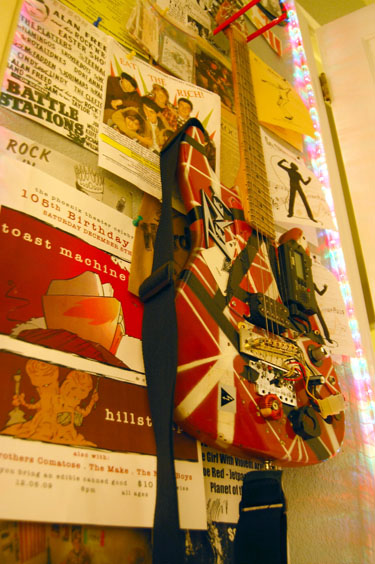By
RICHARD DOBBINS
It happens often that children develop a special attachment to a particular object, usually because it makes them feel safe or secure. Most often, these “security blankets” are simply a blanket, a stuffed bear, or a ball cap. As we grow older, these objects transform before our eyes, taking on a different meaning to us while retaining a special nostalgic value to the owner. Ever since the winter of 2004, I have become closely attached to an object that, at first glance, no one would guess was my own personal “security blanket.” That Christmas, I received something that transformed from an inexpensive gift into something that represents who I am on many levels.
The first time I picked up my guitar and played it that Christmas morning, it became an inseparable part of my anatomy. I spent hours in my room, running my hands up and down the neck, trying to become familiar with the notes and fingering positions. I constantly studied the teach-yourself-guitar book that came with it, and in no time I was playing the basic chords and plucking out a few recognizable melodies. That guitar kept me busy for my two years of middle school, and my obsession with it provoked me to start a band with a group of close friends. I was very grateful for this opportunity, because I was a very shy person by nature (I am still slightly so today), and being a member of that band taught me how to feel comfortable in front of an audience. Playing that guitar boosted my confidence as a child, and for that I am eternally grateful.

As I got older, that guitar’s meaning changed a little. With the amount of time I spent playing with it, the guitar began to rapidly wear down. The wood of the fretboard began to darken where my fingers had pressed down the strings countless times before. The wiring became loose, and the signal would crackle in and out whenever I plugged it into my amplifier. This prompted me to persuade my parents to buy me a new guitar, one that I could reliably play on stage. The very day I got my new guitar, I took the old one, removed every piece of hardware, and stripped it down to the bare wood. As a child, I spent my days building with LEGOS and K-nex, and as I grew older, my fascination with engineering led me to dismantle broken computers and CD players. Curious to find out what made it tick, I did the same with my old guitar. Except that this time, I was armed with the intention of putting it back together and making it better than it was when I got it. Like the Six-Million-Dollar Man, I had the technology (not to mention the ambition and curiosity).
The first thing I did was brainstorm a cool paint job to replace the boring jet-black look that the guitar was born with. At the time, I was really into Van Halen, and I had learned all about Eddie’s famous “Frankenstrat.” Wanting to follow in his footsteps, I matched the paint job on my guitar with that of the Frankenstrat. I now realize the appropriateness of giving it that likeness, because ever since I first took it apart, my guitar has been modified and changed countless times. I see it as my own “Frankenstein monster.” After painting it, I needed to replace the original pickups with one that I bought at the local music store, so in order to install it, I had to learn how to solder well enough to keep a connection in place. I also had to study countless different wiring diagrams before making the smart decision of sticking with the simplest one. The hardest part was putting the neck back on the guitar. Learning how to adjust the truss rod to tilt the neck at just the right angle was vital, and it took me almost a year to finally figure out. I am proud to say that I have given the guitar a rebirth, and to this day I play it onstage with my band. For me, nothing beats the feeling of rocking out to Led Zeppelin and AC/DC with a monster of a guitar that I can call almost entirely my own. Since I first took it apart, new ideas have manifested themselves in my head, and I always take the opportunity to try them out on my guitar. This guitar is the embodiment of the engineer’s mind that I grew up with, one that I plan to take with me and apply throughout my life.
My guitar has stayed, and always will stay, close to me, given its high nostalgic value. That guitar has so many stories to tell, and whenever I study it, certain aspects of its persona remind me of what I have been through with it. The spot in the paint job that my friend put there when he touched it to see if it was dry, the tuning peg that we placed in an irregular position out of boredom, and the penny that we super-glued to the front all get me reminiscing about what this guitar and I have been through. What began its life as a starter-kit guitar in the hands of a musically driven teenager has transformed into a multi-faceted representation of that same teenager many years later. My passion for music, art, and engineering are all built in (literally and figuratively) to this one instrument. This guitar will never lose its meaning, nor will it cease to grow in value. It is my special “security blanket” because it is my own; it embodies who I was, who I am, and who I want to be.